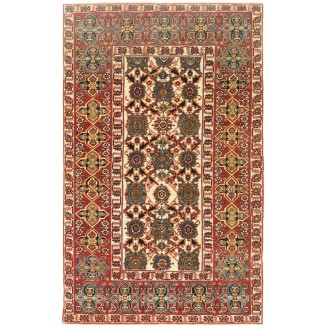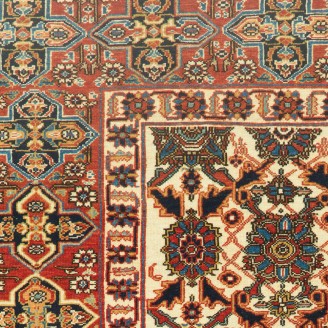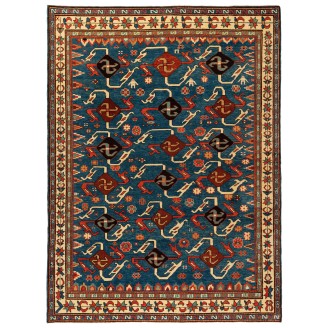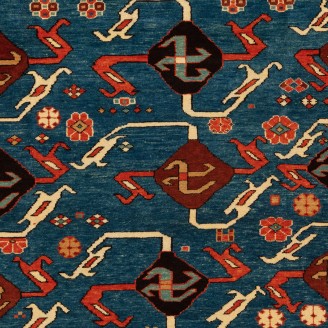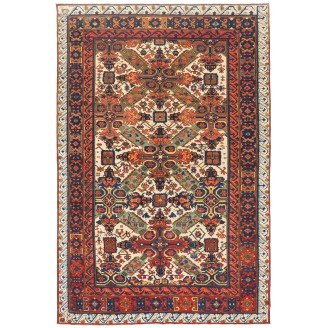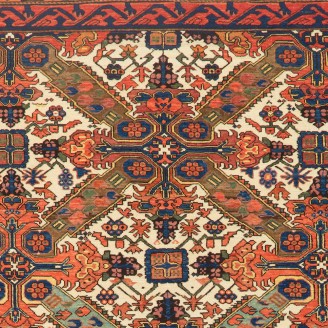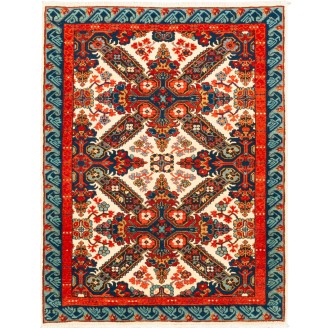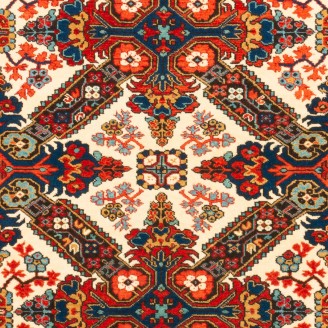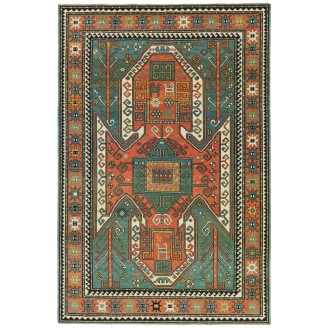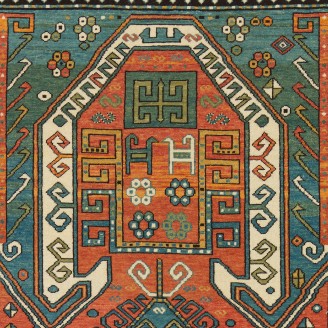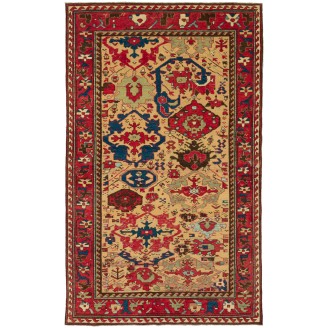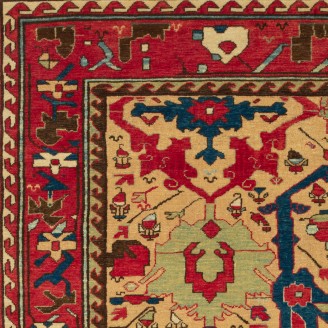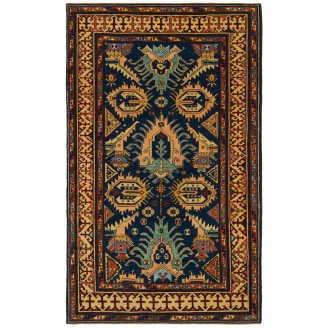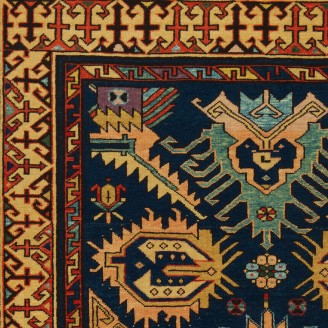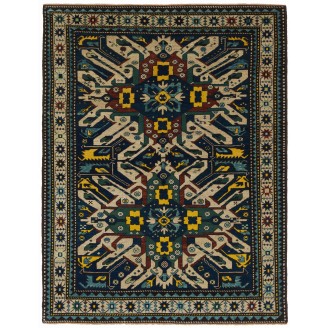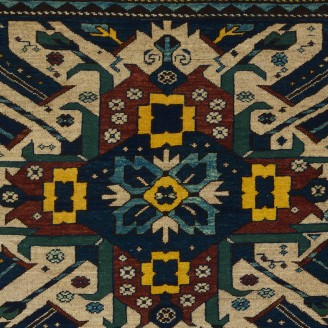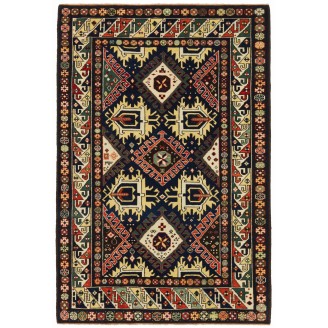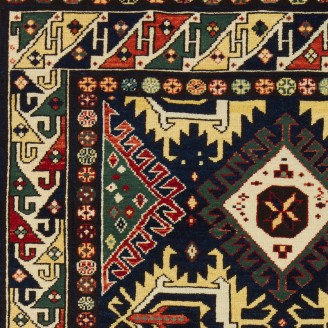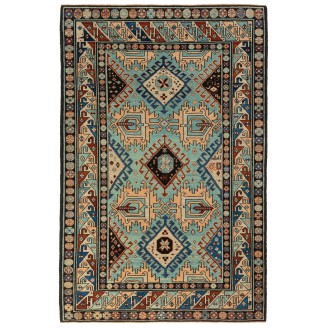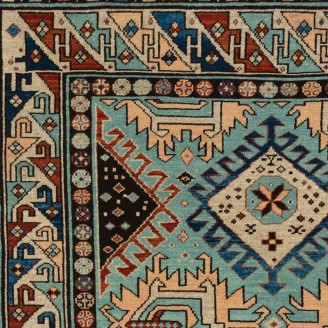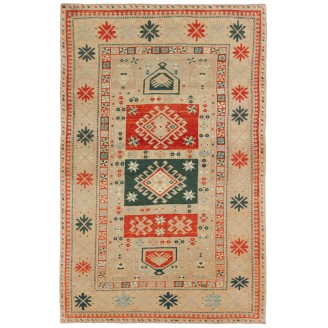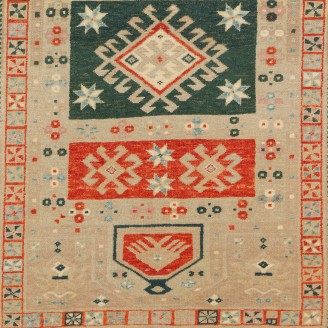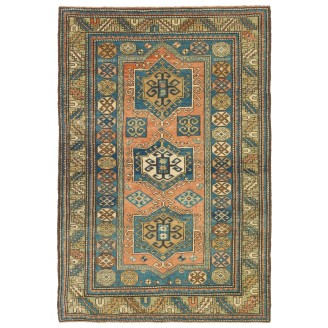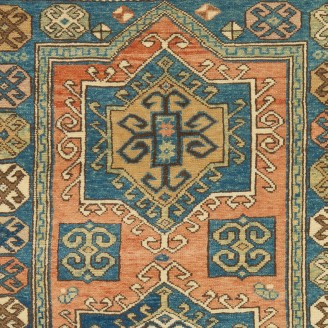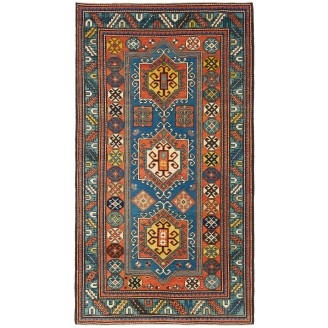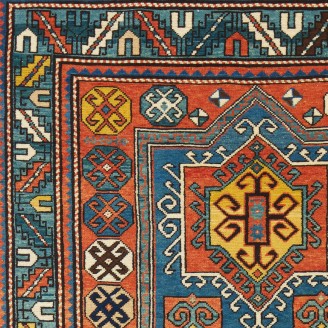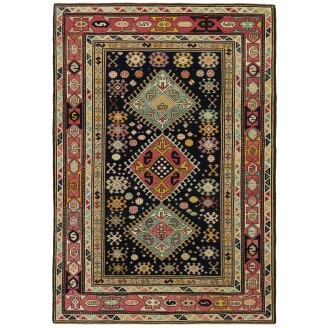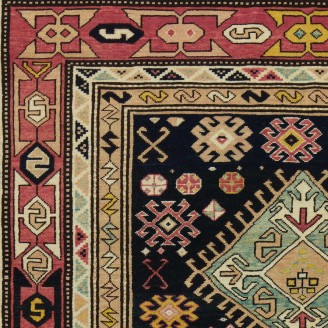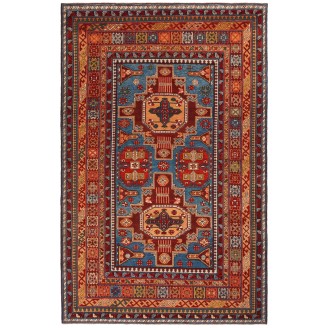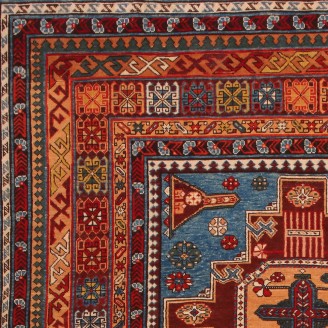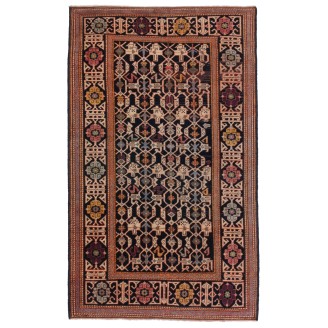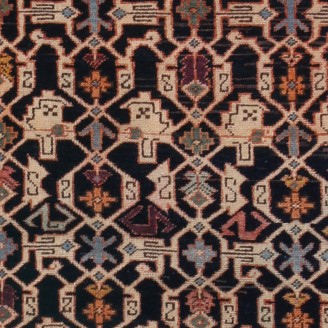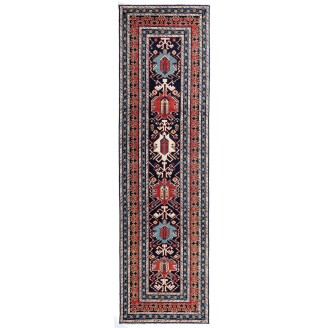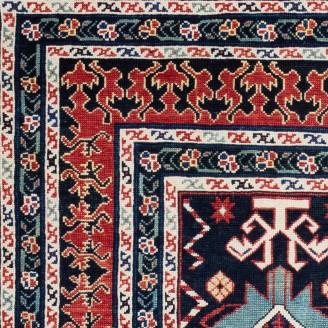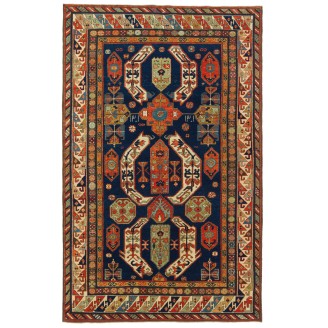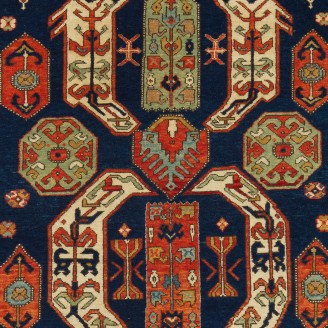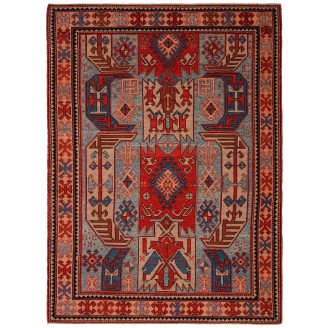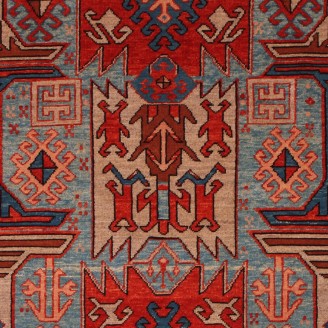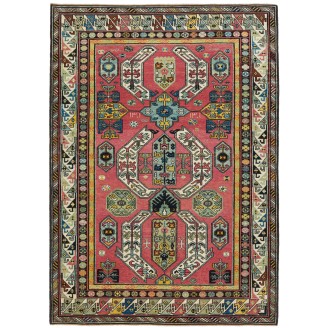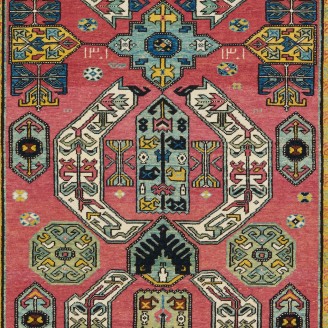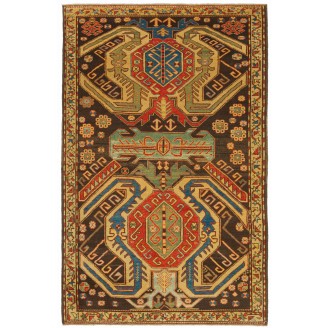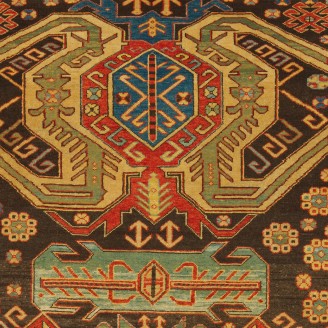COLLECTION OF KAZAK RUGS
Strong folk influence on the designs. Vibrant testaments to the rich weaving traditions of the Caucasus region
Model: ART00617
Dimensions: 4'7" X 7'2"(140cm x 219cm)
The design source of the rug comes from the book Caucasian Carpets, E. Gans-Reudin, Thames and Hudson, Switzerland 1986, pg.284. This is a spectacular example of the Orducth-Konagkend type rug in the late 19th century in the Kuba region, Caucasus. There are three principal designs for rugs attr..
Price:
Save
$5,330
Ex Tax:$5,330
Model: ART00408
Dimensions: 6'7" X 8'9"(201cm x 268cm)
The source of the rug comes from the book Orient Star - A Carpet Collection, E. Heinrich Kirchheim, Hali Publications Ltd, 1993 nr.17. This is a remarkable and very unusual swastika designed early 19th-century rug from the Central Caucasus area. This unusual pattern is not known on other rugs but is..
Price:
Save
$9,200
Ex Tax:$9,200
Model: ART00607
Dimensions: 5'9" X 8'8"(177cm x 266cm)
The source of the rug comes from the book Tapis du Caucase - Rugs of the Caucasus, Ian Bennett & Aziz Bassoul, The Nicholas Sursock Museum, Beirut, Lebanon 2003, nr.90 and Oriental Rugs Volume 1 Caucasian, Ian Bennett, Oriental Textile Press, Aberdeen 1993, pg.376 and Ca..
Price:
Save
$8,520
Ex Tax:$8,520
Model: ART00294
Dimensions: 3'9" X 4'11"(115cm x 150cm)
The source of the rug comes from the book Tapis du Caucase - Rugs of the Caucasus, Ian Bennett & Aziz Bassoul, The Nicholas Sursock Museum, Beirut, Lebanon 2003, nr.90 and Oriental Rugs Volume 1 Caucasian, Ian Bennett, Oriental Textile Press, Aberdeen 1993, pg.376 and Caucasian Carpets, E. Gans-..
Price:
Save
$2,800
Ex Tax:$2,800
Model: ART00467
Dimensions: 6'2" X 9'3"(188cm x 283cm)
The source of the rug comes from the book Tapis du Caucase - Rugs of the Caucasus, Ian Bennett & Aziz Bassoul, The Nicholas Sursock Museum, Beirut, Lebanon 2003, nr.7 and Oriental Rugs Volume 1 Caucasian, Ian Bennett, Oriental Textile Press, Aberdeen 1993, nr.17 and Caucasian Carpets, E. Gans-Re..
Price:
Save
$5,500
Ex Tax:$5,500
Model: ART00563
Dimensions: 4'10" X 7'11"(149cm x 243cm)
The design source of the rug comes from the book Orient Star – A Carpet Collection, E. Heinrich Kirchheim, Hali Publications Ltd, 1993 nr.28. This is a Harshang design rug with palmettes from the early 19th century, Azerbaijan region, Eastern Caucasus or Northwest Persia area. A particular descendan..
Price:
Save
$6,200
Ex Tax:$6,200
Model: ART00449
Dimensions: 4'8" X 7'7"(144cm x 233cm)
This is a Bidjov Kazak rug, designed late 19th century, is a type of handwoven rug that originated from the Caucasus region, specifically from the town of Bidjov, a few miles north of Marasali. As with many place names, the attribution to Bidjov is by no means certain; this group as a whole seems cl..
Price:
Save
$3,790
Ex Tax:$3,790
Model: ART00535
Dimensions: 4'9" X 6'1"(145cm x 186cm)
The design source of the rug comes from the book Tapis du Caucase - Rugs of the Caucasus, Ian Bennett & Aziz Bassoul, The Nicholas Sursock Museum, Beirut, Lebanon 2003, nr.29 and Oriental Rugs Volume 1 Caucasian, Ian Bennett, Oriental Textile Press, Aberdeen 1993, nr.93 and Caucasian Carpets, E...
Price:
Save
$3,600
Ex Tax:$3,600
Model: ART00483
Dimensions: 4'2" X 6'3"(128cm x 191cm)
This is a Derbend Kazak rug also known as Daghestan rug, designed late 19th century, is a type of handwoven rug that originate from the Caucasus region, specifically from the town of Derbend (also spelled as Derbent) in modern-day Dagestan, Russia. Derbend rugs have a rich history that dates back ce..
Price:
Save
$2,750
Ex Tax:$2,750
Model: ART00580
Dimensions: 4'3" X 6'3"(132cm x 192cm)
This is a Derbend Kazak rug also known as Daghestan rug, designed late 19th century, is a type of handwoven rug that originate from the Caucasus region, specifically from the town of Derbend (also spelled as Derbent) in modern-day Dagestan, Russia. Derbend rugs have a rich history that dates back ce..
Price:
Save
$2,970
Ex Tax:$2,970
Model: ART00419
Dimensions: 4'6" X 6'11"(138cm x 211cm)
The source of the rug comes from the book Tapis du Caucase - Rugs of the Caucasus, Ian Bennett & Aziz Bassoul, The Nicholas Sursock Museum, Beirut, Lebanon 2003, nr.46. This is a double migrab prayer rug from the late 19th century, Genje ( Gendje ) region, Caucasus area. There are hooked medalli..
Price:
Save
$3,300
Ex Tax:$3,300
Model: ART00411
Dimensions: 4'0" X 5'9"(122cm x 177cm)
This is another Kazak example of the Fachralo, a town north of Lori-Pambak and just southwest of Bordjalou, from the late 19th-century, Caucasus area. It has given its name to a number of usually small, boldly designed, and brilliantly colored Kazak rugs but, although this has proved a useful descri..
Price:
Save
$2,500
Ex Tax:$2,500
Model: ART00364
Dimensions: 4'0" X 7'1"(122cm x 218cm)
This is another Kazak example of the Fachralo is a town north of Lori-Pambak and just southwest of Bordjalou, from the late 19th century, Caucasus area. It has given its name to a number of usually small, boldly designed, and brilliantly colored Kazak rugs but, although this has proved a useful desc..
Price:
Save
$3,100
Ex Tax:$3,100
Model: ART00537
Dimensions: 5'5" X 7'8"(167cm x 236cm)
This is a complete hooked field with double medallions rug from the late 19th century, Kazak region, Caucasus area. A striking field design features three medallions each with concentric hook motifs, with S patterns in the center of the medallions. It is framed with a series of borders. Vivid colors..
Price:
Save
$3,960
Ex Tax:$3,960
Model: ART00435
Dimensions: 7'1" X 10'10"(218cm x 332cm)
The source of the rug comes from the book Oriental Rugs Volume 1 Caucasian, Ian Bennett, Oriental Textile Press, Aberdeen 1993, nr.332. This is a spectacular example of the Konagkend type rug in the late 19th century in the Kuba region, Caucasus. There are three principal designs for rugs attributed..
Price:
Save
$5,800
Ex Tax:$5,800
Model: ART00457
Dimensions: 3'7" X 6'1"(111cm x 186cm)
The source of the rug comes from the book How to Read - Islamic Carpets, Walter B. Denny, The Metropolitan Museum of Art, New York 2014 fig.87. This is a domestic carpet, village, and nomadic weaving in the late 19th century in the Shirvan region, Caucasus. There are three principal designs for rugs..
Price:
Save
$2,300
Ex Tax:$2,300
Model: ARTK0028
Dimensions: 2'11" X 10'4"(91cm x 316cm)
The source of the rug comes from the book Oriental Rugs Volume 1 Caucasian, Ian Bennett, Oriental Textile Press, Aberdeen 1993, pg.244. This is a single vertical palmette design rug from the early 19th century, Kuba region, Caucasus area. This is an unusual stylized version of the Caucasian shield-l..
Price:
Save
$6,500
Ex Tax:$6,500
Model: ART00442
Dimensions: 5'8" X 9'0"(175cm x 275cm)
The source of the rug comes from the book Tapis du Caucase - Rugs of the Caucasus, Ian Bennett & Aziz Bassoul, The Nicholas Sursock Museum, Beirut, Lebanon 2003, nr.52. This is a unique geometric design rug from the late 19th century, Lenkoran region, Caucasus area. These made their first recognizab..
Price:
Save
$4,900
Ex Tax:$4,900
Model: ART00452
Dimensions: 5'2" X 7'0"(160cm x 214cm)
The source of the rug comes from the book Tapis du Caucase - Rugs of the Caucasus, Ian Bennett & Aziz Bassoul, The Nicholas Sursock Museum, Beirut, Lebanon 2003, nr.52 and Orient Star - A Carpet Collection, E. Heinrich Kirchheim, Hali Publications Ltd, 1993 nr.8. This is a highly stylized "sickl..
Price:
Save
$3,400
Ex Tax:$3,400
Model: ART00504
Dimensions: 5'6" X 7'10"(170cm x 240cm)
The source of the rug comes from the book Tapis du Caucase - Rugs of the Caucasus, Ian Bennett & Aziz Bassoul, The Nicholas Sursock Museum, Beirut, Lebanon 2003, nr.52. This is a unique geometric design rug from the late 19th century, Lenkoran region, Caucasus area. These made their first recogn..
Price:
Save
$4,700
Ex Tax:$4,700
Model: ART00450
Dimensions: 4'3" X 6'7"(130cm x 203cm)
The source of the rug comes from the book Oriental Rugs Volume 1 Caucasian, Ian Bennett, Oriental Textile Press, Aberdeen 1993, pg.160. A distinctive group of Talish rugs is named after the southeast coastal town of Lenkoran. They are distinguished primarily by their design, which consists almost al..
Price:
Save
$2,950
Ex Tax:$2,950
